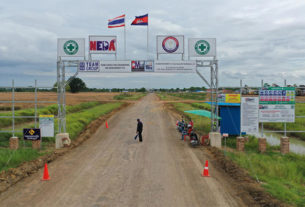One of the world’s great rivers defines the geography of Southeast Asia .
 Rising frozen in the Tibetan highlands and running through
Rising frozen in the Tibetan highlands and running through
Our voyage down the Mekong began in northern
We set off from Chiang Khong, on the Thai side of the river. Here we boarded the flimsy, narrow, “longtail” ferry boats, luggage and a dozen passengers jumbled together, to be poled across the current for the brief crossing into
The
The converted river barge, our “slow boat,” 35 meters long, originally a cargo vessel – solid, wood-built – was simple and practical. There were covered decks with comfortable seats, cushions and rugs, benches and tables, adequate toilet, a bar with coffee, tea and mineral water freely available at all times, and service that was pleasant and helpful. Our luggage was stowed in the hold, and for the two days on board we made do with an overnight rucksack.
We set sail at 11 a.m. on our 300 km. voyage south down the legendary
The river landscape here is totally unspoiled, and life untouched by modernity. At times the river is quite narrow and running fast, with sharp rocky outcrops, rapids and whirlpools which demand skillful navigation.
The unpredictable waters and shifting bed make fording or bridging almost impossible. Tribal villages are set back from the river and the population is sparse.
Farm animals grazing (buffalo, cattle, goats) and small patches of cultivated land can be seen on the shore.
Fishermen leave bamboo fish traps unattended, rods and nets attached to the rocks, floating in the water waiting for the catch.
In the dry season when the
This backbreaking work can bring in a few flakes of gold in a day. We were told that panners can pick up to five grams a month, which doesn’t seem much. But this could bring them $100.
An hour later the boat crunches up on to the pebbly beach and we step ashore, climbing over the sand dunes and into the forest, to visit the Hmong
The Hmong practice animism, a belief in the sentient spirit of all things. Their priest or shaman communicates with this spirit world and with the spirits of the ancestors. Their homes are simple bamboo huts on stilts, with no electricity, water pumped from wells and no access to the outside world other than by river boat. Everything looked clean and well maintained.
The village has a small government school.
The villagers took little notice of us as we walked through the village, making no attempt either to beg or to sell goods.
We returned to our slow boat for a delicious lunch cooked on board – rice with meat and vegetables and freshly caught river fish steamed and served in a banana leaf package, followed by fruit and tea. It was now somewhat cool, and we wrapped up in the blankets provided and laid back. The world floated by, the timeless scenery of
Recommended only if you are a thrill freak and really short of time.
Night sailing is not allowed. The halfway stop for the slow boats is the small town of
There are several simple guest houses, all much the same, all pretty basic. There is a market, and the main street is lined with eating places and shops aimed at the visitors.
Our cruise package included accommodation outside the town, at the top-of-the market Luang Say Lodge, a series of attractive wooden cabins, beautifully situated overlooking the river, linked by wooden walkways. Not luxurious by any means, but quite acceptable. Our room was spacious and the beds comfortable, but electricity here is sporadic, there is no reception for mobile phones, the mosquitoes are bothersome and we never managed to coax hot water from the gas heater. Never mind – dinner and breakfast were excellent and when we woke up in the morning, the view across the river was superb.
The slow boat was gradually bringing us closer to civilization.
The tribal village visited on our second day was less primitive than the previous one, with villagers greeting the visitors, demonstrating their craft skills and offering embroidery and woven articles for sale.
The main crop is cotton, and we saw villagers spinning and weaving. This tribe combines animism with Buddhism and a brand new temple was shown to us with much pride.
Our final excursion was a visit to the Pak Ou caves, an important Buddhist shrine. The boat was moored to the rocks, and the caves reached after a steep climb up the cliff. The cave temple is an ancient repository for thousands of Buddha images, discarded as damaged or replaced by new models. The lower cave has just enough natural light for viewing the rows and rows of serenely smiling statues. The upper one is dark and a flashlight is needed.
Our river voyage ended at Luang Prabang. As we approached, signs of development could be seen on both sides, logging of forests, mining, roads with trucks, urbanization and the villages more densely populated with concrete houses. Our brief respite in the wilderness was over, and our slow boat tied up for the last time.
Luang Prabang is the jewel in the Laotian crown.
Neatly laid out on a promontory between the Mekong and
It is possible to continue voyaging down the
Source: http://www.jpost.com/Travel/TravelNews/Article.aspx?id=196089
